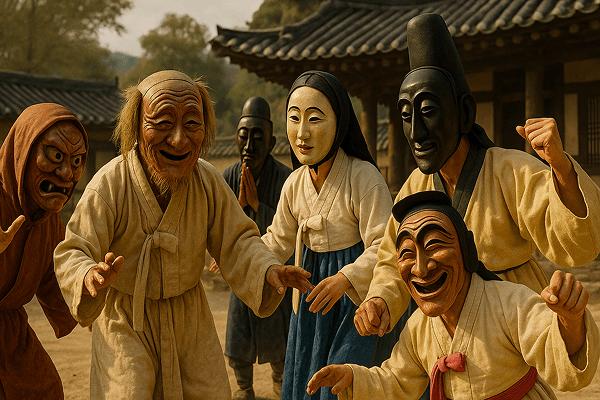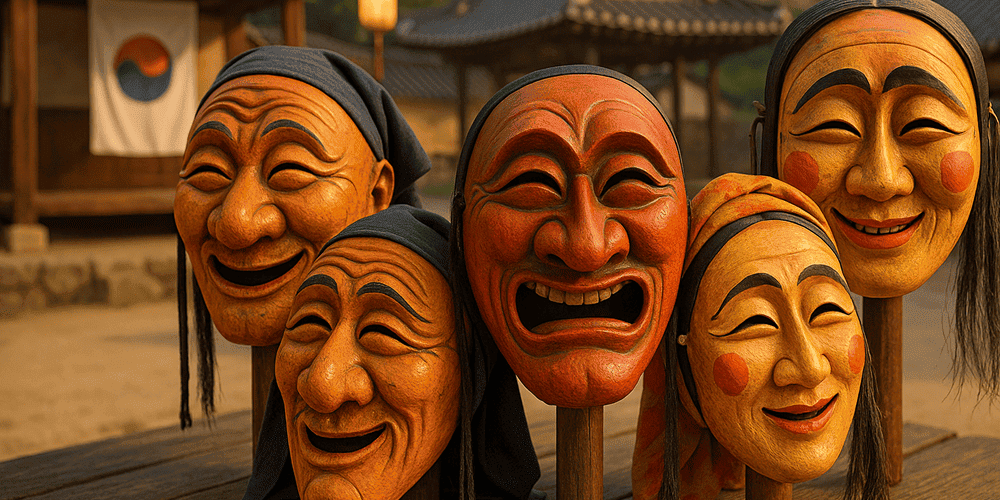Sandae Masks are a cornerstone of Korean traditional performance art, particularly known for their role in the Sandae Noli mask dance-drama. These masks, originating from the Gyeonggi and Gyeongsang provinces, are instantly recognizable for their exaggerated facial features, vibrant colors, and expressive designs. Sandae Masks are typically crafted from wood, gourds, or paper-mâché, and are used to depict a rich cast of characters, from noblemen and monks to clowns and spirits. Emerging during the Joseon Dynasty (14th–19th centuries), Sandae Masks reflect the social, spiritual, and comedic aspects of Korean life, making them an essential part of the country’s intangible cultural heritage.
Historical Origins: The Story Behind Sandae Masks
The history of Sandae Masks dates back to the late Goryeo and early Joseon periods, when mask dance-dramas became a popular form of entertainment and ritual in Korean villages. The term “Sandae” is believed to refer to a raised stage or platform, indicating the theatrical context in which these masks were used. Sandae Noli performances, accompanied by music and dance, evolved as a fusion of shamanic rituals, folk storytelling, and satire of the ruling classes. Over time, the design and function of Sandae Masks have adapted to reflect changing social values and artistic trends. Notable historical artifacts include masks recovered from ancient tombs and temple sites, as well as references in royal records and folk literature. The development of Sandae Masks parallels other Korean mask traditions, such as Byeolsin Masks, which hold similar ritual significance.
Cultural Significance and Symbolism: The Meaning of Sandae Masks
Sandae Masks are deeply woven into the fabric of Korean cultural and spiritual life. Each mask represents a specific character or archetype, often embodying moral lessons, social critique, or supernatural power. For instance, masks may depict yangban (aristocrats), monks, young women, elderly men, or grotesque demons. The exaggerated features are not merely artistic choices — they symbolize the traits, virtues, or vices of each role. In shamanic and ritual contexts, wearing a Sandae Mask is believed to invite blessings, ward off evil, or facilitate communication with the spirit world. The social function of Sandae Noli performances has always been to entertain, educate, and bring communities together, often by satirizing authority and highlighting common human struggles. Legends and folk tales frequently mention the transformative power of these masks, reinforcing their symbolic value in Korean tradition.

Materials and Craftsmanship: Creating Sandae Masks
Traditional Sandae Masks are crafted using locally sourced materials, such as carved wood (often alder or paulownia), gourds, or paper-mâché. Artisans begin by sketching the mask’s design, then carve or mold the basic shape, paying close attention to facial details. The surface is smoothed and painted with bold mineral pigments — red, black, white, and yellow are common. Decorative elements may include horsehair, cloth, or metallic accents. Tools such as chisels, knives, and brushes are essential in this process. Regional differences exist: some areas prefer more naturalistic masks, while others favor abstract or comical features. The color symbolism is important — red for vitality, black for protection, white for purity, and yellow for wisdom. The diversity of design reflects the variety of characters and stories depicted in Sandae Noli performances.
Functions and Use: Sandae Masks in Ritual and Theatre
Sandae Masks are primarily used in Sandae Noli, a traditional Korean mask dance-drama performed at festivals, village gatherings, and religious rituals. These performances blend music, dance, comedy, and social commentary, with masked actors enacting stories that range from the sacred to the satirical. Masks are also used in shamanic ceremonies to invoke spirits, bring good fortune, or drive away malevolent forces. Over time, the use of Sandae Masks has evolved, with performances now featured in national festivals, educational programs, and international cultural exchanges. The enduring appeal of Sandae Noli is matched by that of other Korean mask traditions, such as Byeolsin Masks, which are used in similar contexts.
Regional Variations: Diversity of Sandae Masks Across Korea
Sandae Masks display significant regional variation, reflecting local histories, beliefs, and artistic preferences. In the Gyeonggi region, masks are known for their intricate carving and subtle facial expressions, while those from Gyeongsang tend to be bolder and more exaggerated. Some areas have unique mask characters, specific to local legends or rituals. When compared to other Asian mask traditions, Sandae Masks are notable for their humor, social critique, and dynamic use of color and form. The interplay between Sandae Masks and other Korean mask types, such as Hahoe or Byeolsin Masks, highlights the complexity and richness of Korea’s masking heritage.
Famous Examples and Collections: Where to See Sandae Masks
Significant collections of Sandae Masks can be found in the National Folk Museum of Korea, the Andong Mask Museum, and regional cultural centers throughout the country. These institutions showcase masks from different periods and regions, along with costumes, musical instruments, and performance records. Historical finds, such as ancient wooden masks and performance scripts, offer valuable insight into the evolution of Sandae Noli. Private collectors and online galleries, including toddmasks.com, also provide resources for those interested in learning about or acquiring authentic Sandae Masks.

Influence on Art and Culture: Sandae Masks in Modern Creativity
Sandae Masks continue to inspire contemporary artists, performers, and designers. Their bold forms and expressive features have been reinterpreted in painting, sculpture, film, and even fashion. In literature and music, the imagery of Sandae Masks is used to explore themes of transformation, identity, and resistance. Modern theatre and dance groups frequently incorporate Sandae Masks into experimental performances, ensuring their continued relevance in Korea’s vibrant cultural landscape. The preservation and celebration of Sandae Masks play a key role in maintaining Korean cultural identity and fostering artistic innovation.
Modern Status and Preservation: Passing Down the Sandae Mask Tradition
Today, the tradition of Sandae Mask-making and performance is upheld by master artisans, cultural organizations, and educational institutions. Workshops, festivals, and public demonstrations help to transmit traditional skills to younger generations. Modern adaptations include the use of new materials, digital media, and collaborations with international artists, but the core values of craftsmanship and storytelling remain unchanged. National and local governments support the documentation, exhibition, and teaching of Sandae Mask traditions, ensuring their survival and growth in the 21st century.
Collecting and Acquisition: The Market for Sandae Masks
The market for Sandae Masks is active, with both antique and contemporary pieces available through museums, specialty shops, and online galleries such as toddmasks.com. Prices vary depending on age, craftsmanship, provenance, and artistic value. Collectors are advised to seek documentation of authenticity, understand the cultural context, and support ethical sourcing. By respecting the traditions and communities behind Sandae Masks, collectors contribute to the preservation of an important aspect of Korean heritage.
